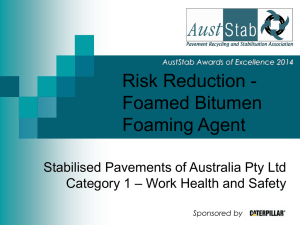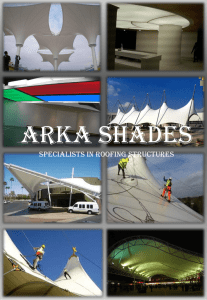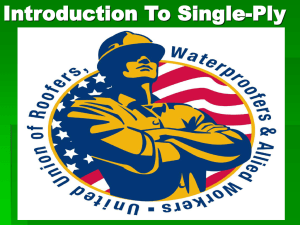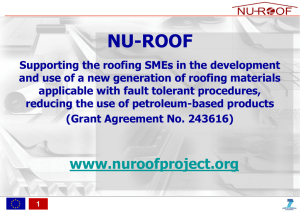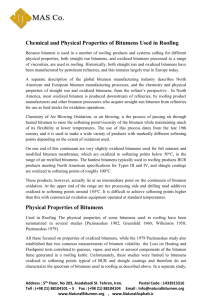Modified bitumen membrane - NU-ROOF
advertisement
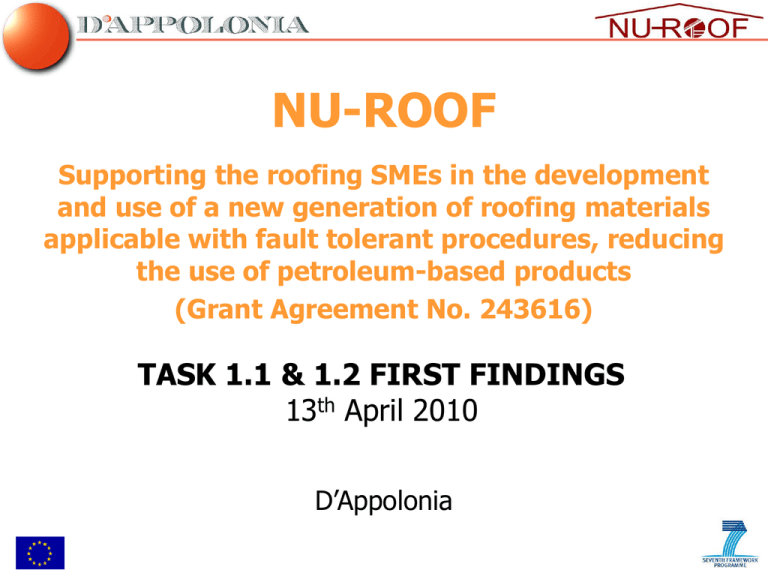
NU-ROOF Supporting the roofing SMEs in the development and use of a new generation of roofing materials applicable with fault tolerant procedures, reducing the use of petroleum-based products (Grant Agreement No. 243616) TASK 1.1 & 1.2 FIRST FINDINGS 13th April 2010 D’Appolonia Objective of the presentation: task 1.1 & 1.2 T1.1 COMPETITORS AND TECH TRENDS (Leader: DAPP) T1.3 STANDARDS AND LEGISLATION NEEDS (Leader: STFI) T1.2 CUSTOMER NEEDS AND PROMISING MARKETS (Leader: IFD) Proactive feed backs T1.4 CONCEPT DESIGN: TECHNICAL SPECIFICATIONS AND MATERIAL DESCRIPTION (Leader: TNO) Proactive feed backs T2.1 T2.2 2 T2.3 Waterproof membrane is part of many different flat roof systems, each one with different requirements Non trafficable roof: membrane must be heat reflective, easy to clean, many colors, resist to wind and punctures,.. Green roof; membrane must be root resistant Solar cells roofs: membrane must be like non trafficable + allowing an excellent grip for solar cells Heavy duty (car park decks, pedestrian,..): membrane must be compatible with the external layers, very thick, long rolls, flexible, extra strong, well fastened 3 Since the 70’s the following technologies have been established Roofing membranes Bitumen membranes BUR Traditional Plastic membranes Single layer Single layer Modified bitumen SBS APP Thermoset EPDM CR PIB Bitumen based membrane are mainly of two typologies both used in multi layers structures also defined as Built Up Roofing (BUR) or in single layer: – Traditional bitumen – Modified bitumen based Plastic Based membrane are mainly of two typologies applied in single lay: – Thermoset membrane – Thermoplastic membrane Spray Polyuretane Foam is a rigid, closed cell, spray polyurethane foam insulation. The foam is composed of two components: isocyanate and polyol. A second protective layer, typically is a spray applied elastomeric coating Liquid applied resins + reinforcement fleece: Spray Polyurethane Foam Based 4 Thermoplastic PVC TPO Liquid Applied Resins Emerging market needs* for waterproofing membranes (1) * Sources: cool roof rating council; catalogues, interviews to NU roof5 project partners and roofing associations, users forums Emerging market needs* for waterproofing membranes (2) * Sources: cool roof rating council; catalogues, interviews to NU roof project partners and roofing association, users forums 6 Summary of Interesting Technology Trends 7 Key players and interesting products Carlisle offers a variety of EPDM, TPO, PVC membranes Carlisle also offers a full line of roof garden systems and energy-saving polyisocyanurate insulation to complement any membrane installation. CCW MiraDRI 860/861 CCW MiraDRI 860/861 are self-adhering sheet membranes consisting of 56 mils (1.4 mm) of rubberized asphalt laminated to 4 mils (0.1 mm) of polyethylene high-performance, extremely durable waterproofing barrier, cost effective but not reflective Single-ply PVC roofing system ideal for commercial or industrial The Duro-Last vinyl roof membrane is a proprietary thermoplastic formulation consisting of PVC resins, plasticizers, stabilizers, biocides, flame retardants and U.V. absorbents. A weft-insertion knitted scrim that is laminated between two layers of PVC film gives the membrane its strength and durability. reflects 88% of the sun's energy TPO and PVC technologies and insulation When properly formulated, VERSIFY™ based TPO formulations allow for faster installation with less room for errors versus incumbent TPO resins. Excellent flame retardant incorporation High temperature range Modified Bitumen membranes “Diamond”: Elastoplastomeric BPP with spunbound polyester reinforcement 8 Key players and interesting products DERBIGUM SP FR modified bitumen: 4mm-thick with 30 years guarantee -A tough sheet of non woven polyester provides resistance to perforation. - Just under the surface, a fiberglass layer protects against UV radiation while assuring perfect dimensional stability. - The bitumen is mixed with high-grade APP polymers to protect against aging and UV radiation. CertainTeed Flintlastic® SA is a premium, self-adhering SBS modified bitumen roofing system comprising a nailable base or self-adhering ply base with a top surface designed to accept self-adhering membrane, a self-adhering mid ply and a self-adhering cap sheet. RubberGard™ EPDM High flexibility and elongation: Firestone RubberGard EPDM remains highly flexible even at temperatures down to -45° C and can also elongate over 300% to accommodate building movements. OTHERS 9 Attachments 10 Built-up Roofing (or BUR) Built-up Roofing (or BUR) is the popular choice for roofing used on commercial, industrial and institutional buildings. BUR is used on flat or low-sloped roofs and consists of multiple layers of bitumen and ply sheets. Components of a BUR system include the roof deck, a vapor retarder, insulation, membrane and surfacing material. The components are assembled at the job site to actually form the built-up roof. At the heart of this roofing system is the roofing membrane, which consists of roofing bitumen and multiple reinforcing plies of roofing felt. Roofing bitumen is the primary adhesion/waterproofing agent used between roofing plies. Bitumen arrives at the job site in solid form, but is heated and applied as a liquid. Roofing bitumens may be either a product of petroleum refining (asphalts) or a product of the coal-cooking process (coal tar pitch). Multiple reinforcing “plies” are asphalt-coated roofing sheets or felts installed in three or more layers to strengthen and stabilize the BUR membrane. These multiple reinforcing felts also make the membrane more pliable and resilient, protect the bitumen from water degradation, and serve as a fire-retarding element in the membrane system. BUR roofing membranes can be protected from solar radiation by embedding gravel in the bitumen, applying a surface coating or applying a granular-surfaced “cap” sheet. Light-colored surfacing materials can be used to reflect heat from the building. In addition, surfacing agents can provide additional fire protection. 11 Modified bitumen membrane Modified bitumen membranes -- MBS -- combine the features of a built-up roof with the added tensile strength from its polymer modification. Using a reinforced sheet that is prefabricated in the plant, modified bitumen systems require a less labor-intensive application and can be applied cross-platform in both commercial and certain residential applications. A modified bitumen roofing system is composed primarily of polymer-modified bitumen reinforced with one or more plies of fabric such as polyester, fiberglass or a combination of both. Factory surfacing, if applied, includes mineral granules, aluminum or copper. The bitumen determines the membrane's physical characteristics and provides primary waterproofing protection, while the reinforcement adds strength, puncture resistance and overall system integrity. Factory-assembled, modified bitumen membranes undergo strict quality control standards to ensure uniform thickness and consistent physical properties throughout the membrane. The finished roofing system is usually a two- to four-ply system consisting of a modified bitumen membrane and a base sheet, with additional plies for added strength if needed. The substrate often determines which ply system is best specified. The finished roofing membrane may consist of one or more modified bitumen sheets, or it may be comprised of a combination of built-up roofing (BUR) felts and one or more modified bitumen sheets. The type of substrate and the performance objectives influence the specification of the modified bitumen membrane system. 12 Modified bitumen membrane Modified bitumens generally use a traditional waterproofing medium -- asphalt -- modified with atactic polypropylene (APP), styrene butadiene styrene (SBS), synthetic rubber or other agents that create a uniform matrix that enhances the physical properties of the asphalt. SBS (Styrene-Butadiene-Styrene) modifies the asphalt by forming a polymer network within the bitumen. SBS gives the bitumen rubber-like characteristics and improved resistance to aging and weathering. Most SBS-modified bitumen sheets are either set in hot mopping asphalt, torch-applied or adhered with cold-process adhesives. SBSmodified bitumen sheets that do not have factory applied granule or foil surfacing need some form of field-applied ultraviolet protective coating. APP (Atactic Polypropylene) is a thermoplastic polymer which forms a uniform matrix within the asphalt. This enhances the bitumen’s performance by increasing its UV resistance, increasing its flexibility at low temperatures and improving its flow resistance at high temperatures. APP-modified bitumen sheets are generally applied using a propane-fueled torch. Applicators use the heat to soften the modified bitumen on the underside of the sheet. The sheet's bottom surface becomes a molten adhesive which flows upon the substrate and then cools to form a waterproof adhesive bond. Some APP sheets can also be applied with cold process adhesives. Ref: http://www.asphaltroofing.org 13 Thermoset (TS) membranes Thermoset (TS) membranes incorporate principal polymers that are chemically cross linked or vulcanized. Membranes that are vulcanized also may be referred to as “cured”. One characteristic of true thermoset polymers is once they are cured, they only can be bonded to similar materials with adhesives. There are five common subcategories of thermoset roof membranes: Ethylene Propylene Diene Monomer (EPDM) Chlorosulfonated Polyethylene (CSPE) Epichlorohydrin (ECH) Neoprene (CR) Polyisobutylene (PIB) The most common thermoset roof membrane is EPDM. EPDM principally is composed of two compounds, ethylene and propylene, that are derived from oil and natural gas. The following are some characteristics of EPDM roof membranes: Sheet widths range from 7.5 feet to 50 feet wide. Sheets are typically 1,5 to 2,5 mm thick. Seams are sealed using liquid adhesives or special formulated tape. The membranes commonly are black, but white is available. REF:www.nrca.net 14 Thermoplastic (TP) membranes Thermoplastic (TP) materials can be repeatedly softened by heating or hardened when cooled. Because of the materials’ chemical nature, thermoplastic membranes typically are seamed by heat welding with hot air or solvent welding. There are different common subcategories of thermoplastic roof membranes. – Polyvinyl Chloride (PVC) – PVC Alloys or Compounded Thermoplastics – Copolymer Alloy (CPA) – Ethylene Interpolymer (EIP) – Nitrile Alloys (NBP) – Tripolymer Alloy (TPA) – Thermoplastic Olefin (TPO) – Chlorinated Polyethylene (CPE) Polyvinyl Chloride (PVC): PVC sheets are produced by calendering, spread coating or extruding, and typically are reinforced with polyester or glass-fiber mats or scrim. PVC sheets contain plasticizers and stabilizers, as well as other additives to impart flexibility and achieve other desired physical properties. Some membranes are available with nonwoven fleece backing adhered to the underside of a sheet. – Sheet widths range from 6 feet to 12 feet wide. – Sheets are typically 1,2 to 1,8 mm mils thick. – Seams are sealed by heat or chemical welding. – PVC membranes are produced in numerous colors, though gray and white are the most common. 15 REF:www.nrca.net SoA : Interesting competitive technologies DESCRIPTION: MiraCLAY membranes, manufactured by Carlisle Coatings and Waterproofing (CCW) REF: http://www.u15287495.onlinehome-server.com/Doco/brochureMiraclay.pdf RELEVANT ASPECT for the project: – Offers significant improvements over traditional bentonite cardboard panels – combines the latest in geotextile technology with the proven waterproofing capabilities of sodium bentonite. – The Infrabond™ process thermally fuses the needle-punched fibers to the polypropylene fabric. – This locks the sodium bentonite into place regardless of incline or hydration cycles, providing a permanently bonded membrane 16 SoA : Interesting competitive technologies DESCRIPTION: INSULATION MATERIAL COMPRISING PHASE CHANGE MATERIAL (PCM) FOR BUILDINGS REF: WIPO Patent Application WO/2007/082559 Applicant: MEINECKE, Bernd; (DE) RELEVANT ASPECT for the project: – Insulation material for the thermal insulation of buildings, in particular roofs and/or walls, with at least one carrier material and at least one heat storage material. – Heat storage material comprises a phase change material (PCM), making possible keep temperature fluctuations low even at the event of changing climate conditions, for example due to different seasons or due to day and night rhythm and, thus, to improve heat protection in summer as in winter times Bulk material PCM in form of beads Carrier material 17 Heat storage material SoA : Interesting competitive technologies DESCRIPTION: New 'Smart' Roof Reads the Thermometer, Saves Energy in Hot and Cold Climates REF: http://www.sciencedaily.com/releases/2010/03/100321203506.htm RELEVANT ASPECT for the project: – Scientists reported the development of a "smart" roof coating, made from waste cooking oil from fast food restaurants, that can "read" a thermometer – The coating automatically switches roles, reflecting or transmitting solar heat, when the outdoor temperature crosses a preset point that can be tuned to the local climate – bio-based intelligent roof coating, compared with a traditional cool roof, could reduce both heating and cooling costs as it responds to the external environment – It will help save fuel and electricity and reduce emissions of volatile organic compounds from petroleum-based roofing products. In addition, it will provide a new use for millions of gallons of waste oil after it is used to cook 18 SoA : Interesting competitive technologies DESCRIPTION: SOY-BASED SEALANT FOR BUILDING CONSTRUCTION REF: compendex:http://www.engineeringvillage.com (Author: Green Products LLC) http://www.greenproducts.net/pages/roofingsolutions.htm RELEVANT ASPECT for the project: – Alternative solution to repair lacks – The recent hike in oil prices has made a strong case for adhesives obtained from natural materials – Plant oil-based adhesives can cut down cure times – advantages in elongation properties, low permeability, low-volatile organic compound levels, and 100% resistance to stain, mildew, and molds and to ultraviolet light. – Applied in tandem with Environmental Liquid Membrane Systems ELMS products that are designed for restoration of roofs and walls – ELMS are applied by brush, roller, or conventional or airless spray equipment 19 SoA : Interesting competitive technologies DESCRIPTION: performance Experiment of geosynthetics improving asphalt pavement REF: www.engineeringvillage.com (author: Key Laboratory of Traffic Engineering, Beijing University of Technology, China ) RELEVANT ASPECT for the project: – prevent rutting and decrease water damage – application research of four kinds of geosynthetics such as glass-fibre geotextile, polyester-fibre geotextile, big-hole geogrid and small-hole geogrid – Contrast reflective cracking defined as the propagation of cracks from the movement of the underlying pavement or base course into and through the new overlay as a result of load-induced and/or temperature-induced stresses. 20 SoA : Interesting competitive technologies DESCRIPTION: Solvent type heat insulation fluorocarbon exterior wall and roof coating REF: Patent : CN20081239554 20081212 RELEVANT ASPECT for the project: isolation coating which uses hollow glass microbeads, hollow ceramic micro-beads 21 SoA : Interesting competitive technologies DESCRIPTION: New DERBIGUM NT range REF: http://www.derbigum.com/EN/EN_solutions-eco-solutions-NT.html RELEVANT ASPECT for the project: With the NT range, DERBIGUM introduces a new generation of ecological and sustainable products generation, while anticipating the more demanding European directives. The NT range is based on new compositions which reduce DERBIGUM’s impact on the environment:: – No Volatile Organic Compounds (VOC): replacing solvents by vegetable oils – Diminished CO2 emissions – Diminished energy consumption aimed at membranes production – Diminish the use of non renewable resources – membrane durability remains Products: DERBIGUM NT Ecological new generation roofing membrane Solution DERBIBRITE NT white reflective energy saving roofing membrane. DERBICOAT NT universal ecological underlayer DERBIBOND NT Ecological bituminous cold adhesive without solvants DERBICLEAN NT Ecological cleaning product 22
